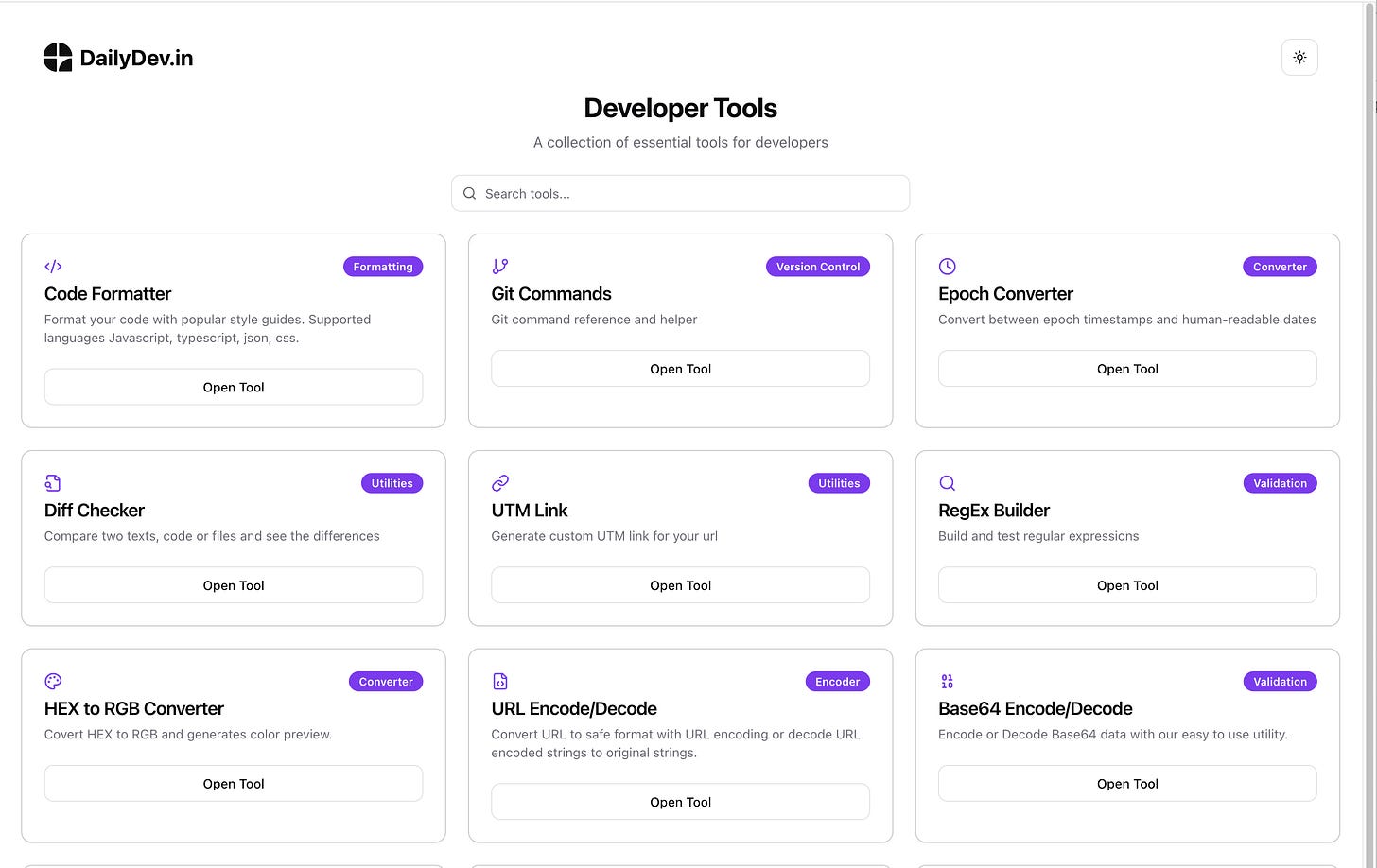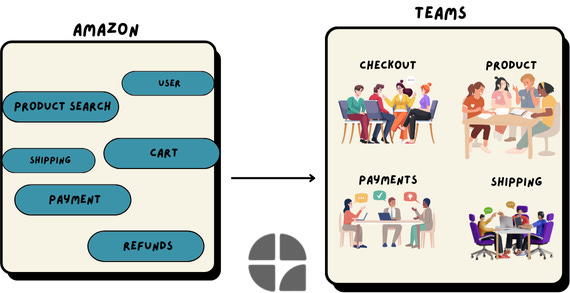SD 4: What are microservices?
Your All-in-One Utility Platform for Developers and Beyond 🚀
Imagine having access to dozens of essential tools in one place—no more switching tabs, searching for utilities, or dealing with daily limits. app.dailydev.in is your ultimate toolbox, offering solutions for developers, analysts, and tech enthusiasts alike.
Here’s what you’ll find:
Code Utilities: Format code, parse JWT, generate UUIDs, and more.
System Tools: Git commands, system utilities, epoch converters.
Data Transformers: YAML ↔ JSON, CSV ↔ JSON, Base64 encoders, and URL encoders.
Design Helpers: Color converters, CSS unit converters, image resizers, and HTML previews.
Analysis Tools: Diff checkers, hash generators, and UTM generators.
💡 Why Choose app.dailydev.in?
Free & Unlimited Access: No restrictions or daily limits.
User-Driven Features: Share feedback, report bugs, or request new tools—we’re here to build what you need.
Time-Saving: Simplify your workflow with everything you need in one platform.
Start exploring today and see how app.dailydev.in can transform your productivity.
Welcome to DailyDev.in, where we help software engineers level up their skills! Today, we're diving into the fascinating world of microservices. Buckle up, tech enthusiasts - this is going to be an exciting ride!
Have you ever wondered how tech giants like Netflix handle massive amounts of data and traffic? The secret sauce is microservices! But what exactly are they, and why should you care? Let's break it down.
🏗️ Microservices: The Building Blocks of Modern Software
Imagine you're constructing a digital city. Instead of building one massive, monolithic structure, you create smaller, specialized buildings that work together seamlessly. That's the essence of microservices!
Q: Can you think of any advantages this approach might have over a single, large structure?
Microservices are like individual Lego blocks that fit together to create a larger, more flexible application. Each "block" or service is:
Self-contained
Focused on a specific function
Independently deployable and scalable
🤔 Think about it: How might this architecture benefit large teams working on complex projects?
Let's take a trip down memory lane to understand how we got here.
📅 The Evolution of Software Architecture
1970s: Computers tackle simple, scientific problems
1990s: Businesses start adopting software solutions
Early 2000s: Social media emerges
Fast forward to today, and software is everywhere! From ordering a ride to transferring money, our daily lives are powered by applications.
🛒 The Amazon Example
Consider Amazon's website. It's not just one big application, but a collection of microservices handling various functions:
Product search
User accounts
Shopping cart
Payment processing
Seller marketplace
Each of these could be a separate microservice, working together to create the Amazon experience we know.
👥 Team Collaboration in Microservices
Imagine you have a team of 50 developers. With microservices, you could:
Divide into 10 teams of 5 members each
Assign each team to a specific service
Allow teams to work independently and choose their preferred technologies
Question for you: How do you think this approach might impact team productivity and innovation?
🏛️ Monoliths vs. Microservices: The Great Debate
Let's compare these two architectural approaches:
Monoliths:
Simple and fast initial development
High performance for smaller applications
Harder to scale as complexity grows
Technology stack limitations
Entire application affected by issues
Microservices:
Easier to scale specific functions
Technology flexibility
Isolated failures
More complex to set up and manage
Requires strong DevOps practices
Fun fact: Google uses a monolithic architecture, while Netflix embraces microservices. There's no one-size-fits-all solution!
🤓 Pop Quiz: Can you name one advantage and one disadvantage of each approach?
🔧 The Nuts and Bolts of Microservices
So, how do these little services talk to each other? Through APIs and protocols like gRPC. It's like each service has its own phone number, and they call each other when they need something.
But wait, it's not all sunshine and rainbows! Microservices come with their own set of challenges:
Service discovery: How do services find each other?
API Gateway: Who manages all the incoming requests?
Resilience: What happens if one service fails?
🚀 Implementing Microservices: More Than Just Coding
Before you start coding, you need to design your microservices architecture carefully. Ask yourself:
How will you divide your application into services?
What communication patterns will you use?
How will you handle data consistency across services?
Remember: Poor design can lead to a distributed mess that's worse than a monolith!
💡 Pro Tip: Start with a monolith and gradually break it into microservices as your application grows and your needs become clearer.
🔐 Security in Microservices
With multiple services, security becomes more complex. You need to consider:
Authentication between services
Authorization for user requests
Data encryption in transit
How would you approach these security challenges in a microservices architecture?
🎭 Real-World Examples
Netflix: Uses microservices to handle millions of streams simultaneously
Uber: Manages ride requests, payments, and driver locations with microservices
Airbnb: Scales its accommodation platform using a microservices approach
Can you think of other companies that might benefit from a microservices architecture?
🧠 Food for Thought
How might microservices impact the way you approach software development?
What skills do you think are crucial for working with microservices?
How could microservices influence your career path in software engineering?
🎉 Wrapping Up
Microservices are revolutionizing the way we build and scale software. They offer flexibility, scalability, and the ability to innovate rapidly. However, they also come with increased complexity and operational challenges.
As a young professional in tech, understanding microservices can give you a significant edge in your career. Whether you're looking to switch jobs or grow in your current role, this knowledge is invaluable in today's software landscape.
🚀 Take Action!
Research a company you admire and try to determine if they use microservices.
Experiment with breaking down a simple application into microservices.
Discuss microservices with your colleagues or in online tech communities.
Remember, the journey to mastering microservices is ongoing. Stay curious, keep learning, and don't be afraid to experiment!
What's your take on microservices? Are you excited to explore this architecture further? Share your thoughts and let's continue this conversation!
Recommended Reads for Your Career Journey
Explore these highly recommended books to deepen your knowledge in System Design, Software Engineering, and Coding:
Designing Data-Intensive Applications by Martin Kleppmann
A must-read for understanding distributed systems and modern data engineering.
View hereSystem Design Interview – An Insider's Guide by Alex Xu
Perfect for preparing for system design interviews with practical case studies.
View hereClean Code: A Handbook of Agile Software Craftsmanship by Robert C. Martin
Learn how to write code that is readable, maintainable, and efficient.
View hereThe Pragmatic Programmer: Your Journey to Mastery by Andy Hunt and Dave Thomas
A timeless guide for becoming a well-rounded software developer.
view hereOperating Systems: Three Easy Pieces by Remzi H. Arpaci-Dusseau and Andrea C. Arpaci-Dusseau
Dive deep into the fundamentals of operating systems.
view here



